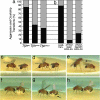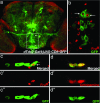Modulation of Drosophila male behavioral choice
- PMID: 17360588
- PMCID: PMC1810337
- DOI: 10.1073/pnas.0700328104
Modulation of Drosophila male behavioral choice
Abstract
The reproductive and defensive behaviors that are initiated in response to specific sensory cues can provide insight into how choices are made between different social behaviors. We manipulated both the activity and sex of a subset of neurons and found significant changes in male social behavior. Results from aggression assays indicate that the neuromodulator octopamine (OCT) is necessary for Drosophila males to coordinate sensory cue information presented by a second male and respond with the appropriate behavior: aggression rather than courtship. In competitive male courtship assays, males with no OCT or with low OCT levels do not adapt to changing sensory cues and court both males and females. We identified a small subset of neurons in the suboesophageal ganglion region of the adult male brain that coexpress OCT and male forms of the neural sex determination factor, Fruitless (Fru(M)). A single Fru(M)-positive OCT neuron sends extensive bilateral arborizations to the suboesophageal ganglion, the lateral accessory lobe, and possibly the posterior antennal lobe, suggesting a mechanism for integrating multiple sensory modalities. Furthermore, eliminating the expression of Fru(M) by transformer expression in OCT/tyramine neurons changes the aggression versus courtship response behavior. These results provide insight into how complex social behaviors are coordinated in the nervous system and suggest a role for neuromodulators in the functioning of male-specific circuitry relating to behavioral choice.
Conflict of interest statement
The authors declare no conflict of interest.
Figures




Similar articles
-
Neurogenetics of courtship and mating in Drosophila.Adv Genet. 2008;62:67-184. doi: 10.1016/S0065-2660(08)00603-2. Adv Genet. 2008. PMID: 19010254 Review.
-
fruitless tunes functional flexibility of courtship circuitry during development.Elife. 2021 Jan 19;10:e59224. doi: 10.7554/eLife.59224. Elife. 2021. PMID: 33463521 Free PMC article.
-
Octopamine neuromodulatory effects on a social behavior decision-making network in Drosophila males.PLoS One. 2010 Oct 12;5(10):e13248. doi: 10.1371/journal.pone.0013248. PLoS One. 2010. PMID: 20967276 Free PMC article.
-
Octopamine neuromodulation regulates Gr32a-linked aggression and courtship pathways in Drosophila males.PLoS Genet. 2014 May 22;10(5):e1004356. doi: 10.1371/journal.pgen.1004356. eCollection 2014 May. PLoS Genet. 2014. PMID: 24852170 Free PMC article.
-
Sexual behavior mutants revisited: molecular and cellular basis of Drosophila mating.Cell Mol Life Sci. 1999 Nov 15;56(7-8):634-46. doi: 10.1007/s000180050458. Cell Mol Life Sci. 1999. PMID: 11212311 Free PMC article. Review.
Cited by
-
The modulatory effects of biogenic amines on male mating performance in Bactrocera dorsalis.Front Physiol. 2022 Sep 6;13:1000547. doi: 10.3389/fphys.2022.1000547. eCollection 2022. Front Physiol. 2022. PMID: 36148306 Free PMC article.
-
Putative transmembrane transporter modulates higher-level aggression in Drosophila.Proc Natl Acad Sci U S A. 2017 Feb 28;114(9):2373-2378. doi: 10.1073/pnas.1618354114. Epub 2017 Feb 13. Proc Natl Acad Sci U S A. 2017. PMID: 28193893 Free PMC article.
-
Masculinized Drosophila females adapt their fighting strategies to their opponent.J Exp Biol. 2021 Mar 25;224(Pt 6):jeb238006. doi: 10.1242/jeb.238006. J Exp Biol. 2021. PMID: 33568440 Free PMC article.
-
Neuromodulation of insect motion vision.J Comp Physiol A Neuroethol Sens Neural Behav Physiol. 2020 Mar;206(2):125-137. doi: 10.1007/s00359-019-01383-9. Epub 2019 Dec 6. J Comp Physiol A Neuroethol Sens Neural Behav Physiol. 2020. PMID: 31811398 Review.
-
Specific subgroups of FruM neurons control sexually dimorphic patterns of aggression in Drosophila melanogaster.Proc Natl Acad Sci U S A. 2007 Dec 4;104(49):19577-82. doi: 10.1073/pnas.0709803104. Epub 2007 Nov 27. Proc Natl Acad Sci U S A. 2007. PMID: 18042702 Free PMC article.
References
Publication types
MeSH terms
Substances
Grants and funding
LinkOut - more resources
Full Text Sources
Molecular Biology Databases

